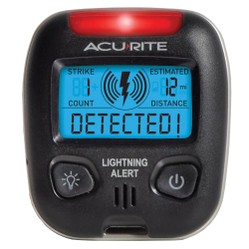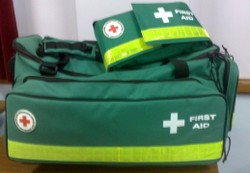I suppose some people think lightning striking a person is a rare event, but the risk is real. I have come close to lightning twice in my life. I shall relate the stories.
When I first started college I found myself in a large auditorium. I knew one person in the class, although not well. We had been in high school together. He was in a similar situation, so we sat together. In the middle of the second semester I opened a newspaper and found his picture on the front page. He had been struck by lightning while playing baseball. He did not survive. Had lightning detectors been in use back then, but they were not yet invented, perhaps he would have survived. The game would have been called off.
In the second case I was in my office at the university where I was teaching when I heard a loud noise. A few minutes later I heard another. They sounded like explosions. I had no window so I went to a room where I could see out, and found campus police, local police, and an ambulance crew working on someone. It was raining, and we were in a thunderstorm. Soon reports came back that three students were struck by lightning as they walked between buildings. Two survived, the other did not. In this case the thunder was particularly loud because it was close and because it was not muffled by rain. Two bolts of lightning preceded the thunderstorm striking before rain began to fall. Not every bolt of lightning stays beneath the cloud, some move out.









 Christmas on Zazzleon 10/21/2025
Christmas on Zazzleon 10/21/2025
 The Linear Equation and Related Equations and Inequalitieson 08/15/2024
The Linear Equation and Related Equations and Inequalitieson 08/15/2024
 Understanding Calculus: A Simplified Approach to Derivativeson 08/05/2024
Understanding Calculus: A Simplified Approach to Derivativeson 08/05/2024
 Limits: Vital Building Blocks of Calculuson 08/01/2024
Limits: Vital Building Blocks of Calculuson 08/01/2024



Comments
Taking the narrow passage between the island and the land ensured that we were surrounded by higher points that might take the impact of a strike. We still feared that it would hit the trees, but we could not avoid them. Getting closer to the cliffs made us feel safer, then we landed the boat and raced through the intensifying storm to our hotel. That night was the worst lightning storm that I have experienced.
Two walkers in Mid Wales were killed recently on the same day independent of each other by a sudden lightning strike on the exposed summits of the Brecon Beacon mountains. Such fatalities are rare in Britain.
I can think of a case some years ago when a climber on an exposed ridge in Scotland was hit by ball lightning. He saw it coming up the ridge at him, but there were deadly drops on either side, so he could not evade the threat. It hit him, and it took several hours to carry him down to Glasgow, where he made a full recovery.
People tend to underestimate lightning. You did the correct thing in seeking selter and avoiding the tall trees.
One of my closest encounters with lightning came when I was rowing on Derwentwater, when lightning struck the lake a hundred yards away from us. As we were on a boat we were at a relatively high point on the surface and therefore in danger. We hurried shorewards aiming first to get under the lee of an island with tall trees and then to hug the small cliffs of the shoreline. The aim of this was to ensure that we were not the highest point. I have also been in mountains when lightning struck somewhere not far above us. We turned round and descended.
We get over 60 inches f rain in an average year, and often get those afternoon thunderstorms as well. Yes, these are helpful devices, but I would think those less familiar with thunderstorms would be more at risk when there is an encounter since the experience is out of the norm. Really, these are great for anyone.
We live in Florida, which has more lightening strikes per square mile than any other state. This time of year, we have afternoon thunder storms at least several times a week. It's not unusual for the weather radar to record upwards of several hundred lightening strikes per hour. A detector for early warning would be most useful!